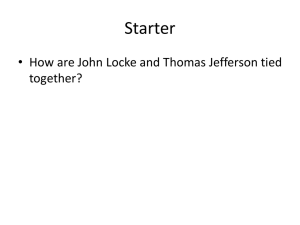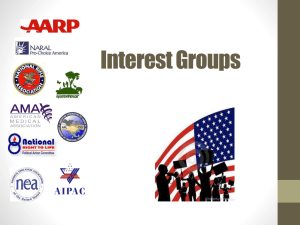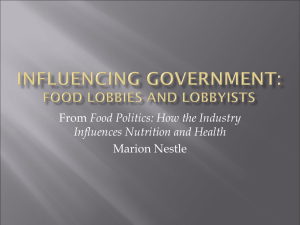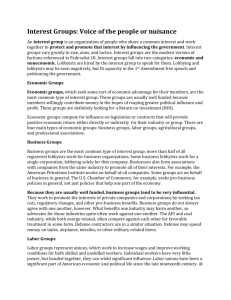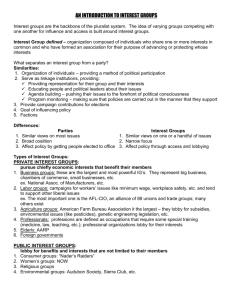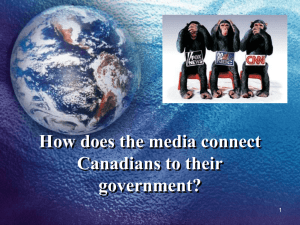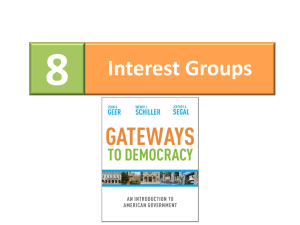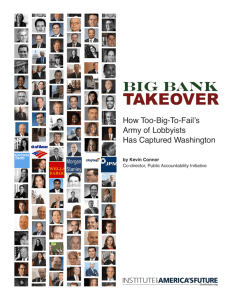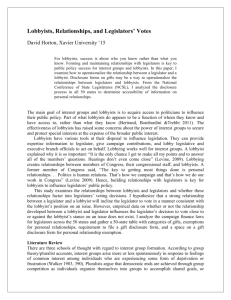interest groups - ilovesocialstudies.com
advertisement
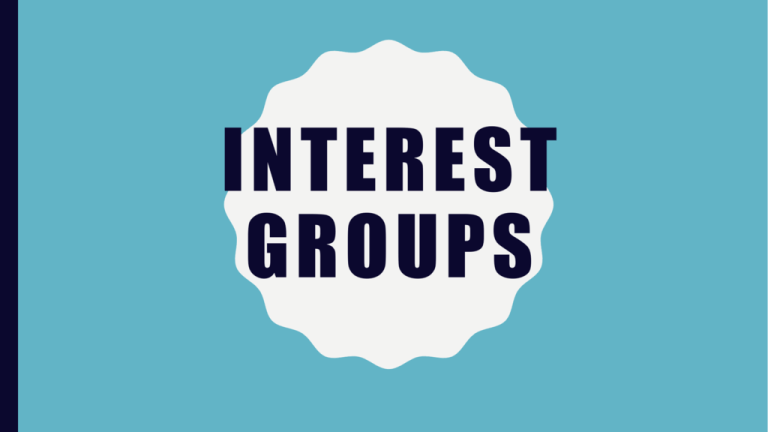
INTEREST GROUPS INTEREST GROUPS • Interest groups represent people or organizations with common concerns and interests. • They work to gain or retain benefits for their members, through advocacy, public campaigns, and even lobbying governments to make changes in public policy. • Interest groups are also involved in activities such as lobbying to directly persuade decision makers in Congress along with members of the executive branch • There are a wide variety of interest groups representing a variety of constituencies including business, labor, consumers, other governments, and various single issue groups. • *A body of voters in a specified area who elect a representative to a legislative body. INTEREST GROUPS • Interest groups may take on a variety of strategies including public education, encouraging public participation, and providing education and special information for civil servants and politicians. • However, interest groups are also involved in activities such as lobbying and forming PACs, which has led to concerns that some groups and even individuals might have disproportionate influence on Congress. Registered interest groups in the United States. ECONOMIC GROUPS • Four Type of Economic Interest Groups • They look to gain economic advantages for members only. • Prevalent in capitalist societies • Powerful at times • High membership with lots of capital – Business Groups – Labor Groups – Agricultural Group – Professional Associations BUSINESS GROUPS • Most common type • More than half of all lobbyists are registered to a business group • Lobbyists will work for a single company or they represent an entire industry – American Petroleum Institute • Represents interests of all oil companies • General goals include: – Tax Cuts – Regulatory Changes – Private Interests • Interests of company A usually compete with B so they may work against one another LABOR GROUPS • Represent unions • At peak, one of every three Americans was in a Union (1950’s) • Represent skilled and unskilled labor • Power in numbers • If union leaders tell members to not vote for someone, they often don’t! • Fight for job security, wages, conditions, benefits, etc. • Less powerful today – 25% of Americans are in Unions • AFL-CIO (American Federation of Labor– Congress of Industrial Organizations) is an umbrella organization – multiple unions work together. AGRICULTURAL GROUPS • Agricultural groups represent the interests of farmers. • Farmers have been organized for centuries to protect themselves against price fluctuations and other issues. • The federal government spends large amounts of money supporting farmers and influencing what crops are grown. • Not all agricultural groups agree on the same policies. Some groups, such as the Farm Bureau, tend to work most closely with large agribusinesses, whereas others, such as the Farmers Union and the Grange, do more to protect family farms. PROFESSIONAL ASSOCIATIONS • Many professionals have formal organizations that set ground rules for the profession, regulate practices, and promote standards of conduct. • Professional associations also lobby the government on issues related to their profession. • AMA – American Medical Association • NEA – National Education Association WHY YOU MIGHT CARE The Food and Drug Administration (part of the bureaucracy) regulates the price and distribution of pharmaceuticals many American depend on. A special interest group could lobby AGAINST lowering the prices cause a pill that fights AIDS to be over $750 per pill! NON-ECONOMIC GROUPS • Fight for causes • Seek public goods (also called collective goods), which benefit everyone in society, not just members of the group. • Instead of material incentives, these groups offer their members a variety of selective incentives, including the following benefits: – Purposive benefits: The emotional and psychological benefits members receive knowing they have contributed to a cause they feel is worthwhile – Solidarity benefits: The social benefits members receive after meeting new people and friends they worked with to promote the cause – Informational benefits: The educational benefits members receive after having learned more about the issues that matter to them • FOUR TYPES: public interest groups, single-issue groups, ideological groups, and government group PUBLIC INTEREST GROUPS • Public interest groups claim to work for the good of the whole society, not just one part of it. • Not surprisingly, public interest groups often have very different ideas as to how to improve society. • Many public interest groups tackle a number of related issues. • Greenpeace, for example, works to protect ecosystems around the world and to educate the public about dangers to the environment. • The nonpartisan public interest group Democracy 21 seeks to strengthen democracy by lobbying for election and campaign finance reforms. SINGLE ISSUE GROUPS • Single-issue groups work solely on one specific issue. • These groups tend to be very strongly driven, composed of members who are passionately committed to the particular cause. • Over the last few decades, the number of singleissue groups has grown greatly; there are now groups covering a broad range of issues. • Well-known single-issue groups include the National Rifle Association, which lobbies against gun control legislation, and Operation Rescue, which works to ban abortion IDEOLOGICAL GROUPS • Whereas single-issue groups have a very narrow focus, ideological groups have much broader aims rooted in a strongly held philosophy. • Ideological groups often work to change cultural norms, values, and prevailing stereotypes. • Conservative ideological groups include the Christian Coalition and the Traditional Values Coalition, whereas liberal ideological groups include the National Organization for Women (NOW) and the National Association for the Advancement of Colored People (NAACP) GOVERNMENT GROUPS • Government groups represent the interests of other government levels or areas. • Many cities and state governments, for example, have lobbyists in Washington to act in their interest. -Fights for municipal improvement -Energy resources -Transportation • Most foreign governments also hire lobbyists to promote their interests in Congress and the White House. -Works on relationship between state and federal levels LOBBYIST LOBBYIST A person remunerated to persuade (to lobby) politicians to vote in a certain way or otherwise use their office to effect a desired result. WHAT’S THE DIFFERENCE? • Lobbyists work for a wide variety of groups, ranging from individual companies and nonprofit organizations, to other governments and large coordinated councils representing whole industries, labor movements, or consumers. • Lobbyists work to directly persuade decision makers in Congress along with members of the executive branch. LOBBYISTS • Lobbyists work for a wide variety of groups – Individual companies – Non-profit organizations – Other governments – Whole industries – Labor movements – Consumers. • Lobbyists work to directly persuade decision makers in Congress along with members of the executive branch. • The way PACs and lobbyists report actions differ • PACs are more focused on raising money for ads • Lobbyists are operating with legislators 527 • Named after the IRS tax exempt code they operate under • Influence the selection, nomination, election, appointment or defeat of candidates to federal, state or local public office • No upper limits on contributions to 527s • No restrictions on who may contribute • Must register with the IRS, publicly disclose their donors and file periodic reports of contributions and expenditures. • Similar to PAC/SUPER PAC but they do not back a person, they back an issue


